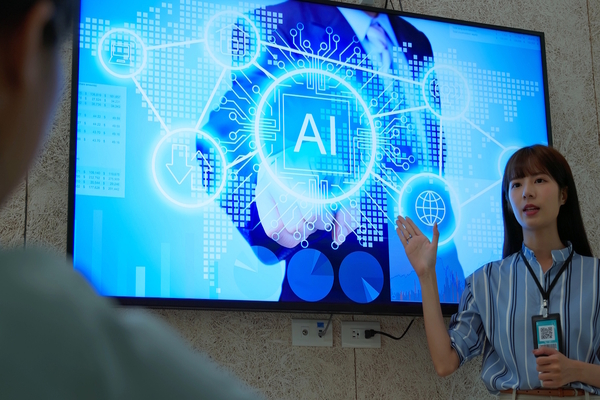AI: hype versus practicality

Bill Conner at Jitterbit navigates the realities of artificial intelligence
In recent years, artificial intelligence (AI) has moved from the realm of science fiction into the forefront of technological innovation, promising to revolutionise everything from healthcare to finance.
The buzz around AI is ubiquitous, fuelled by headlines proclaiming the dawn of a new era where machines outsmart humans, and intelligent systems handle complex tasks with superhuman efficiency. Businesses are eager to jump on the AI bandwagon, but the reality of implementation is often more complex than headlines suggest.
The allure of AI
The allure of AI is undeniable. It promises unprecedented efficiencies, predictive analytics, and the ability to transform massive datasets into actionable insights. This excitement around AI is not misplaced, but it is unrealistic in many senses.
The capabilities of AI have advanced rapidly. Natural language processing (NLP) systems like GPT-4 can generate human-like text, chatbots have become more sophisticated, and machine learning algorithms are improving in their ability to predict trends and patterns.
Companies across industries are investing heavily in AI research and development, anticipating that these technologies will unlock new opportunities and provide competitive advantages.
In the public imagination, AI has been elevated to a near-mythical status, often portrayed as a panacea for virtually every business challenge. However, it is essential to remain grounded with an understanding of AI’s current limitations and practical applications.
The current business landscape is already crowded with numerous applications, many of which haven’t been fully integrated. Many businesses struggle with data quality and legacy systems, making a "rip-and-replace" approach unworkable.
The reality check
Despite the significant progress, AI is not a magic wand that can be waved to instantly solve all problems. Many AI projects fail to move beyond the experimental stage, and those that do often require substantial resources to implement effectively. The journey from prototype to production is fraught with challenges, including data quality issues, integration complexities, and the need for specialised skills.
One of the most persistent misconceptions is that AI can operate independently without human oversight. In reality, AI systems require continuous human involvement to ensure accuracy, relevance, and ethical compliance. For example, machine learning models need regular updates and retraining with new data to maintain their performance.
Additionally, AI decisions must be monitored for bias and fairness, which necessitates a collaborative effort between data scientists, domain experts, and ethicists.
Practical applications
Businesses must focus on how AI can be practically applied to drive value. Integration is one area where AI can make a tangible difference. By leveraging AI-powered integration platforms, businesses can automate the flow of data between disparate systems, improving efficiency and reducing the risk of errors.
One way this can be done is by programming AI algorithms that can identify patterns in data exchange processes and suggest optimizations, leading to faster and more reliable integrations.
Customer service is another domain ripe for AI-driven transformation. Intelligent chatbots and virtual assistants can handle routine inquiries, freeing up human agents to focus on more complex issues.
However, for these solutions to be effective, they must be designed with a deep understanding of customer needs and behaviours. A chatbot that fails to provide accurate and relevant responses can frustrate customers and damage brand reputation.
The key to success lies in leveraging AI to augment human capabilities, not replace them. Here’s how companies can upskill their workforce. For coding-proficient teams, the focus should be on increasing productivity through AI-assisted low-code development tools. For less technical teams, the goal is to bridge the gap between business needs and technical execution. With AI-powered tools, business professionals can translate their requirements into code and data integrations, collaborating with IT for finalisation.
Reskilling and redeploying talent
As we harness the power of AI, it is imperative to adopt a responsible approach to its deployment. Ethical considerations should be at the forefront of AI development as businesses implement the technology into their everyday operations. This includes ensuring transparency in how AI systems make decisions, protecting user privacy, and addressing potential biases in data and algorithms.
Businesses must then invest in upskilling their workforce to work alongside AI. The integration of AI into business processes should be seen as an opportunity to augment human capabilities, not replace them!
AI is best utilised as a teammate that complements human strengths. By automating repetitive tasks, AI frees employees to focus on critical thinking, emotional intelligence, and empathy – areas where human expertise remains irreplaceable. By providing employees with the tools and training they need to leverage AI effectively, companies can foster a culture of innovation and continuous improvement.
Looking ahead
The future of AI is undoubtedly promising, but it is essential to navigate this journey with a balanced perspective. While the hype surrounding AI can lead to unrealistic expectations, a pragmatic approach focused on practical applications and responsible deployment can yield substantial benefits.
As we move forward, it’s crucial to not view AI as a cure-all, but as a powerful tool that, when used wisely and uniquely to each business, can transform the way we live and work. By bridging the gap between hype and practicality, we can unlock the true potential of AI and build a future that is both technologically advanced and human-centric.
Bill Conner is the CEO of Jitterbit
Main image courtesy of iStockPhoto.com and alexsl

Business Reporter Team
Most Viewed
Winston House, 3rd Floor, Units 306-309, 2-4 Dollis Park, London, N3 1HF
23-29 Hendon Lane, London, N3 1RT
020 8349 4363
© 2025, Lyonsdown Limited. Business Reporter® is a registered trademark of Lyonsdown Ltd. VAT registration number: 830519543





